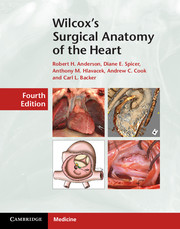Book contents
- Frontmatter
- Contents
- Preface
- Acknowledgements
- Surgical approaches to the heart
- Anatomy of the cardiac chambers
- Surgical anatomy of the valves of the heart
- Surgical anatomy of the coronary circulation
- Surgical anatomy of the conduction system
- Analytical description of congenitally malformed hearts
- Lesions with normal segmental connections
- Lesions in hearts with abnormal segmental connections
- Abnormalities of the great vessels
- Positional anomalies of the heart
- Index
- References
Surgical anatomy of the valves of the heart
Published online by Cambridge University Press: 05 September 2013
- Frontmatter
- Contents
- Preface
- Acknowledgements
- Surgical approaches to the heart
- Anatomy of the cardiac chambers
- Surgical anatomy of the valves of the heart
- Surgical anatomy of the coronary circulation
- Surgical anatomy of the conduction system
- Analytical description of congenitally malformed hearts
- Lesions with normal segmental connections
- Lesions in hearts with abnormal segmental connections
- Abnormalities of the great vessels
- Positional anomalies of the heart
- Index
- References
Summary
It is axiomatic that a thorough knowledge of valvar anatomy is a prerequisite for successful surgery, be it valvar replacement or reconstruction. The surgeon will also require a firm understanding of the arrangement of other aspects of cardiac anatomy to ensure safe access to a diseased valve or valves. These features were described in the previous chapter. Knowledge of the surgical anatomy of the valves themselves, however, must be founded on appreciation of their component parts, the relationships of the individual valves to each other, and their relationships to the chambers and arterial trunks within which they reside. This requires understanding of, firstly, the basic orientation of the cardiac valves, emphasising the intrinsic features that make each valve distinct from the others. This information must be supplemented by attention to their relationships with other structures that the surgeon must avoid, notably the conduction tissues and the major channels of the coronary circulation. For this chapter, throughout our narrative we will presume the presence of a normally structured heart, lying in its usual position, and without any coexisting congenital cardiac malformations.
THE VALVAR COMPLEXES
When considering the valves, we distinguish between the atrioventricular valves, which guard the atrioventricular junctions, and the arterial valves, which guard the ventriculoarterial junctions (Figure 3.1). The atrioventricular valves are best analysed in terms of the valvar complex, made up of the annulus, the leaflets, the tendinous cords, the papillary muscles, and the supporting ventricular musculature (Figure 3.2). All of these components must work in harmony so as to achieve valvar competence. The leaflets of the atrioventricular valves are supplied with a complex tension apparatus, as they must withstand the full force of ventricular systole, so as to retain their competence when in their closed position. The arterial valves are also a combination of complex anatomical parts.
- Type
- Chapter
- Information
- Wilcox's Surgical Anatomy of the Heart , pp. 51 - 89Publisher: Cambridge University PressPrint publication year: 2013

